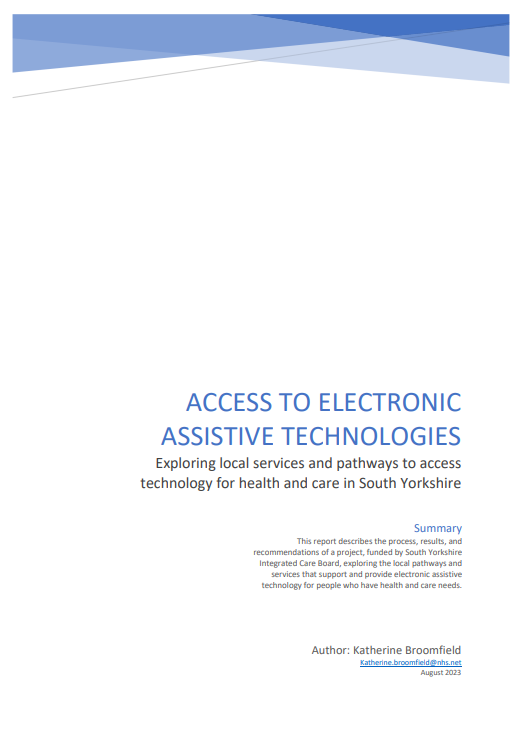| Authors | Zoë Clarke Kath Broomfield |
|---|---|
| Journal | South Yorkshire ICB, November 2023 |
| DOI | https://www.barnsleyhospital.nhs.uk/assistive-technology/publication/access-to-electronic-assistive-technologies-eat/ |
| File | Download Other Publication |

| Authors | Zoë Clarke Kath Broomfield |
|---|---|
| Journal | South Yorkshire ICB, November 2023 |
| DOI | https://www.barnsleyhospital.nhs.uk/assistive-technology/publication/access-to-electronic-assistive-technologies-eat/ |
| File | Download Other Publication |

This report describes the process, results, and recommendations of a project, funded by South Yorkshire Integrated Care Board, exploring the local pathways and services that support and provide electronic assistive technology for people who have health and care needs.
In 2015 specialised services were established for Alternative and Augmentative Communication (AAC) and Environmental Control (EC), with the goal of ensuring that there is an equitable service for people requiring these electronic assistive technologies (EAT).
Great work goes on in local teams to maximise the potential of those who do not meet specialist service criteria, however there are some groups of people who potentially may not get the same level of service due to the complexity of their physical and cognitive disabilities. A project, funded by the South Yorkshire Integrated Care Board (ICB), was initiated in 2022 to explore local pathways for access to EAT (including AAC and EC) across Barnsley, Sheffield, Doncaster, and Rotherham. This project considered EAT broadly and its potential impact on a person having some level of independent control. Clinicians from health services, social workers and occupational therapists in local authorities, specialists in special schools, and the managers of day and residential services were invited to take part in an online individual- or a team- conversations. The aim of these conversations was to find out about arrangements for EAT assessment, provision, and access to support for people accessing their services who do not meet specialised services criteria.
Information was gathered from several health and local authority staff across the South Yorkshire area in early 2023. Pathways to access for EAT varied greatly across the area and were significantly different across health and social care providers. People reported challenges in levels of awareness, in access to equipment for assessment and practise, and limitations in services or pathways for people who may not be able to use EAT functionally and consistently, and in a range of situations.
It is recommended that further work is required to raise awareness about the potential benefits of EAT for people with complex disabilities and embed technology skills in the health and care workforce. Access to EAT equipment for assessment and trial periods could be supported at a regional or ICB level utilising existing infrastructure. Improved consistency in messaging about the advantages of technology for independent control across ICB footprint may help to increase awareness and engagement with technology across services.